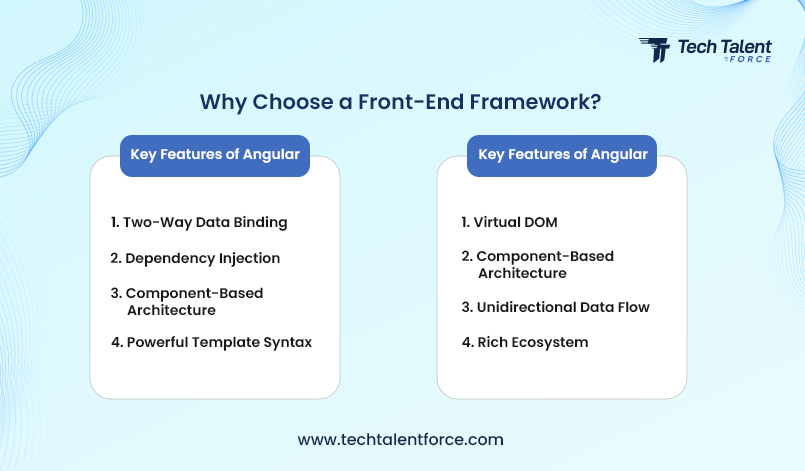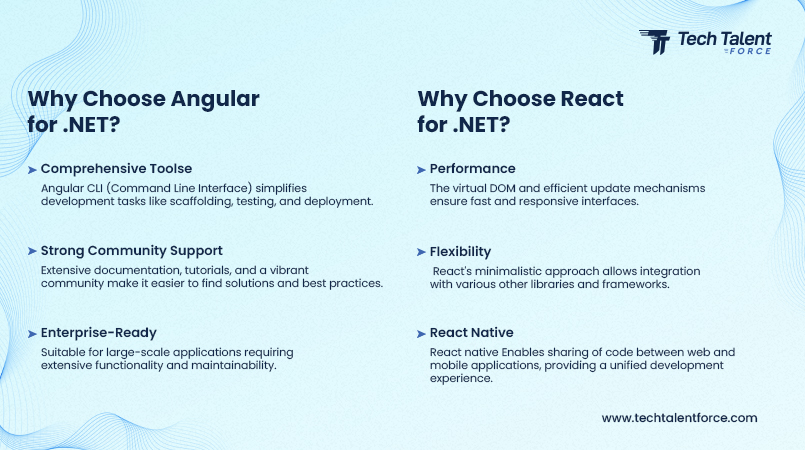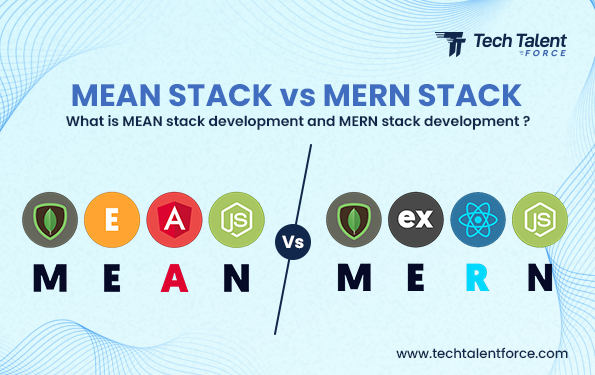Introduction:
In the ever-evolving landscape of web development, selecting the appropriate front end framework to pair with your .NET backend is crucial for your project’s success. With a plethora of frameworks at your disposal, determining the one that best complements your .NET Core or .NET Framework applications can be a daunting task. Each framework comes with its own set of features, benefits, and potential drawbacks, making it essential to carefully evaluate your project’s specific needs and goals before making a decision.
Why Choose a Front-End Framework?

Before diving into specific frameworks, it’s essential to understand why a robust front-end framework is crucial for your .NET applications:
1. User Experience:
A responsive and interactive front-end enhances user engagement.
2. Development Efficiency
Frameworks offer reusable components, reducing development time.
3. Maintainability
Structured codebases and modular architectures simplify maintenance and scaling.
Angular: A Comprehensive Front-End Solution
What is Angular?
Angular is a platform and framework designed for building single-page client applications using HTML and TypeScript. Developed by Google, Angular offers a comprehensive solution for front-end development, equipped with a rich set of features. Its robust architecture enables the creation of dynamic, responsive web applications with ease. Angular provides powerful tools for data binding, dependency injection, and modular development, making it a preferred choice for developers seeking to build scalable and maintainable applications. Additionally, Angular’s extensive documentation and active community support contribute to its popularity and effectiveness in delivering high-quality web applications.
Key Features of Angular
- Two-Way Data Binding: Automatically syncs data between the model and the view.
- Dependency Injection: Enhances testability and modularity.
- Component-Based Architecture: Encourages reusable and maintainable code.
- Powerful Template Syntax: Facilitates dynamic and complex views.
Why Choose Angular for .NET?
Angular’s robust features and structured approach make it an excellent choice for .NET developers:
- Comprehensive Toolset: Angular CLI (Command Line Interface) simplifies development tasks like scaffolding, testing, and deployment.
- Strong Community Support: Extensive documentation, tutorials, and a vibrant community make it easier to find solutions and best practices.
- Enterprise-Ready: Suitable for large-scale applications requiring extensive functionality and maintainability.
React: A Flexible Front-End Library
What is React?
React is a JavaScript library for building user interfaces, maintained by Facebook. It emphasizes the view layer and is suitable for building single-page applications. React’s component-based architecture allows developers to create reusable UI components, which can lead to more efficient and organized code. Its virtual DOM enhances performance by minimizing direct manipulations to the real DOM, resulting in faster and more responsive user experiences. Additionally, React’s ecosystem includes tools like React Router for navigation and Redux for state management, making it a versatile choice for developers aiming to create complex, interactive applications. React’s large and active community, along with comprehensive documentation and a rich ecosystem of libraries and tools, further strengthens its position as a leading front-end technology.
Key Features of React
- Virtual DOM: Boosts performance by reducing direct manipulation of the actual DOM.
- Component-Based Architecture: Promotes reusability and easier debugging.
- Unidirectional Data Flow: Improves data management and predictability.
- Rich Ecosystem: Includes libraries like Redux for state management and React Router for navigation.
Why Choose React for .NET?
React’s flexibility and ecosystem make it a strong contender for .NET projects:
- Performance: The virtual DOM and efficient update mechanisms ensure fast and responsive interfaces.
- Flexibility: React's minimalistic approach allows integration with various other libraries and frameworks.
- Flexibility: React's minimalistic approach allows integration with various other libraries and frameworks.
- React Native: React native Enables sharing of code between web and mobile applications, providing a unified development experience.
Comparing Angular and React for .NET

When choosing between Angular and React for your .NET applications, consider the following factors:
Learning Curve
- Angular: Strong community with comprehensive documentation and built-in solutions for common tasks.
- React: Extensive ecosystem with a wide range of third-party libraries and tools.
Project Requirements
- Angular: Ideal for large-scale, feature-rich applications requiring a structured and opinionated framework.
- React: Best suited for projects needing flexibility, performance, and a modular approach.
Integrating with .NET Backend
Regardless of whether you choose Angular or React, both frameworks can seamlessly integrate with your .NET backend, including .NET Core and Azure services. Here are a few integration tips:
- API Communication: Use RESTful APIs or GraphQL to connect your front-end with .NET backend services.
- Azure DevOps: Implement continuous integration and continuous deployment (CI/CD) pipelines to streamline development and deployment processes.
- Authentication: Utilize OAuth or JWT tokens for secure authentication between your front-end and .NET backend.
Conclusion
Choosing the right front-end framework for your .NET applications depends on your specific project requirements and team expertise. Angular offers a comprehensive and opinionated approach, ideal for large-scale applications, while React provides flexibility and performance for projects needing a more modular approach.
By understanding the strengths and weaknesses of each framework, you can make an informed decision that aligns with your project’s goals and ensures a seamless integration with your .NET backend.
Whether you opt for Angular or React, both frameworks provide the tools and capabilities needed to build robust, interactive, and scalable web applications that leverage the power of .NET.





No Comments